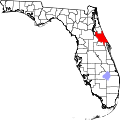Flagler Beach, Florida | |
|---|---|
| City of Flagler Beach | |
 Scenic view of Flagler Beach Pier | |
 Location in Flagler County and the state of Florida | |
| Coordinates: 29°28′27″N81°07′37″W / 29.47417°N 81.12694°W | |
| Country | |
| State | |
| County | Flagler |
| Incorporated | April 16, 1925 [1] |
| Government | |
| • Type | Commission-Manager |
| • Mayor | Patti King |
| • Commissioners | James Sherman, John Cunningham, Eric Cooley, Rick Belhumeur, and Scott Spradley |
| • City Manager | Dale Martin |
| • City Clerk | Penny Overstreet |
| Area | |
• Total | 4.09 sq mi (10.58 km2) |
| • Land | 3.58 sq mi (9.28 km2) |
| • Water | 0.50 sq mi (1.30 km2) 9.8% |
| Elevation | 10 ft (3 m) |
| Population (2020) | |
• Total | 5,160 |
| • Density | 1,439.73/sq mi (555.83/km2) |
| Time zone | UTC-5 (EST) |
| • Summer (DST) | UTC-4 (EDT) |
| ZIP code | 32136 [3] |
| Area code | 386 |
| FIPS code | 12-22550 [4] |
| GNIS feature ID | 0307132 [5] |
| Website | cityofflaglerbeach |
Flagler Beach is a city in Flagler County in the U.S. state of Florida. The population was 5,160 at the 2020 census.
Contents
- Geography
- Demographics
- 2010 and 2020 census
- 2000 census
- Attractions
- America's Coolest Small Town finalist
- Retirement location
- Flagler Beach Historical Museum
- Fire department
- References
- External links
Flagler Beach is part of the Deltona–Daytona Beach–Ormond Beach, FL metropolitan statistical area. It is named for oil tycoon and Florida railroad developer Henry Flagler, who was a key figure in the development of East Florida as resort and vacation destinations.


